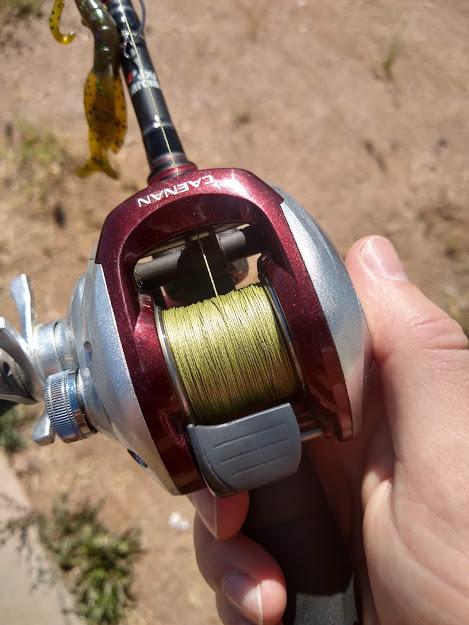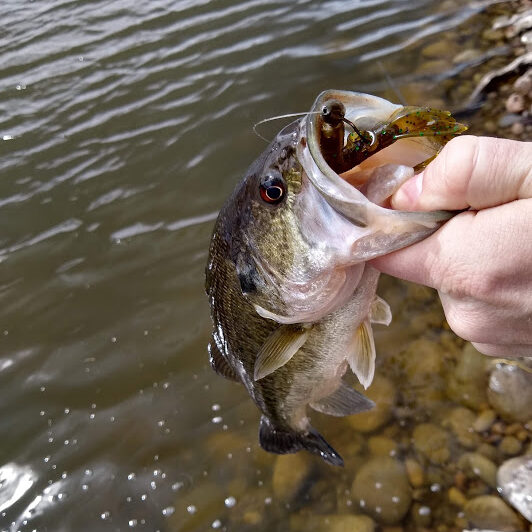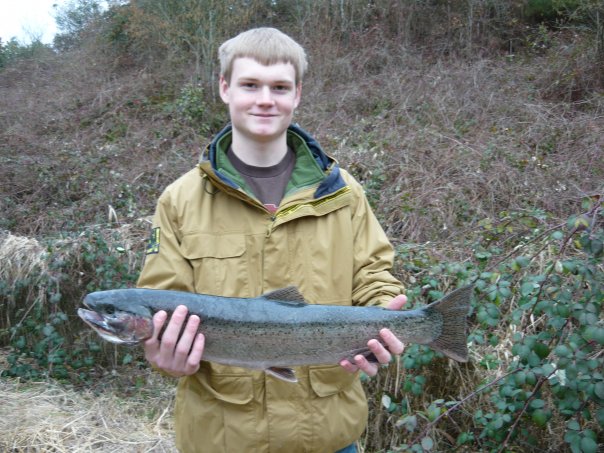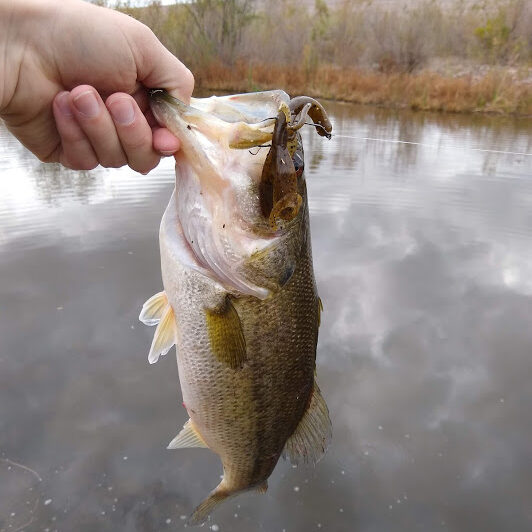I remember when I was first learning to fish I would have a hard time trying to tell the difference between a bite and a snag. This is particularly difficult when drift fishing for shad, steelhead salmon or trout, but It can also be tricky when fishing lures or jigs for other species like bass.
Nothing can help you get the feel more than just spending time on the water, but in case you can’t get out right now, here are some tips that may help.
Here’s a list of things that can help you better detect whether it’s a bite or a snag.
- Use a more sensitive rod
- Try using braid
- Watch your line closely
- Keep tension on your line
- Get to know the river bottom
- Know what a fish bite feels like
- Use less weight
- Don’t cast too far
- Practice, practice, practice
What is a Snag?
In fishing terms, a snag is when your hook gets stuck on something by accident. Usually anglers get snagged on underwater rocks, logs, weeds, and brush. The term snagging fish is where anglers cast out and try to hook the backs, bellies, or sides of the fish, and is usually illegal.
Use a Sensitive Fishing Rod
Detecting a bite is all about feel and understanding what is going on with your hook underwater. This comes both through experience, and using the best tools.
The fishing rod is one of the tools that can help us to visualize what is happening with our hook. A more sensitive rod will have better energy transfer so when your hook comes in contact with something whether a snag or a fish, that information will travel up the line, through the rod, and into your hand.
There is a huge difference between the sensitivity of a $20 rod and a $80 rod with the same specs.
A more sensitive rod will usually have a stiffer backbone and be lighter weight. Unfortunately I can’t tell you exactly what to get because it depends on what fish you are targeting, and what bait, lure, and fishing method you are using.
Use a More Sensitive Fishing Line
Another important tool we have to help us detect bites is our fishing line. There are a number of lines out there, but I’m going to focus on the three most popular. Monofilament, fluorocarbon, and braid.

Mono是最弹性的三个。至于年代ensitivity goes, stretch is not a good thing. Mono still has it’s place in the fishing world and is the most common line out there, but if you really want to dial in your bite sensitivity, then consider fluoro or braid.
Fluorois a little less stretchy than mono. However, it is quite a bit more expensive. If you don’t mind the price, then it is a great option for trout, steelhead, salmon, and most other species.
Braidis the most sensitive of the three lines. It doesn’t have any stretch to it, so when combined with a good rod, you can feel every rock pebble and snag. Braid is popular in the bass fishing world, but can be used when drift fishing for salmon and steelhead as well. I always add a few feet of mono or fluoro leader to the end so I can still have the benefits of a less visible line close to the hook.
If you want to learn more, check out my article aboutfishing line.
Watch Your Line
There are times when you may see your line move before you feel the bite of the fish. You may also feel your hook stop on something, and by watching your line, you can tell the difference between a snag and a bite.
It can be especially difficult to detect a bite as your hook is sinking through the water. This is the time you likely have the most slack in your line.
Watch closely to where the fishing line is entering the water. If you see that it’s doing something strange such as moving against the river current, or being pulled off to the side in still water then reel in the slack and set the hook. You may also notice it stops sinking before it should have reached the bottom, or goes completely slack on the way down.
What to Watch For
1. If your line goes slack when it shouldn’t be, then it’s likely that a fish has taken the bait and is swimming towards you.
2. When you are in still water and see the line being pulled off to the side one way or another, then the fish is swimming away with it.
3. If you are in a river, and the line not only stops, but moves upstream, then a fish has taken the bait and moved up.
It sounds obvious, but a snag won’t swim off with your hook. Now where the line gets blurred, is when you snag on a stick, or someone else’s fishing line. These will bend, stretch, and even seem to pull back. If you aren’t sure whether it’s a bite or a loose snag, hold your line tight, with your rod bent, and see if you can feel the headshake or vibration of a fish.

Watching your line is very important when finesse fishing with jigs or soft plastics for bass. When you are popping your baits along the bottom, there may be moments when you have some slack in you line. This is often when the bite happens. You may also feel tension in your line and wonder if it’s a bite or a snag. Look closely at where your line enters the water, and if it is moving off to the side then it’s definitely a fish!
Many anglers who want to see their line clearly, will use a hi viz colored fishing line. If you do so, make sure you still use a leader of less visible line so the fish don’t notice it.
Stay in Contact With Your Hook
The key to knowing what is going on with your hook underwater, is to stay in contact. This means not only using a sensitive rod and line, but also making sure there’s as little slack as possible in your system.
You can have the most sensitive rod, line, and fishing rig, but if you have a bunch of slack line out, you will never feel the bite.
This is important for almost all types of fishing. Remember the contact you have with your hook is what transmits the information into your hand.
The most difficult time to keep contact is during the fall. That’s why I explained above, the importance of watching your line. But with practice, you can keep some level of contact. When you cast out, immediately pick up the slack and hold your rod up high. Then lower your rod steadily as the hook sinks through the water. As it’s falling, feel for even the lightest tap and set the hook.
Use Less Weight
Sinkers can be both good and bad when it comes to sensitivity and detecting a bite. Having some weight at the end of your line helps to keep tension and prevent slack from forming in your line. However, too much weight can prevent you from feeling light bites.
Having the right amount of weight is especially important when drift fishing in rivers for salmon, steelhead, and trout. You need just enough weight so that your sinker is tapping the bottom once every 2 or 3 seconds.

Try to use as little weight as possible while still getting your bait to the correct depth. If you are using too much weight, the sinker will be dragging along the bottom and bouncing constantly. When this happens it is very difficult to tell the difference between a bite, a rock, or some other snag.
Learn The River or Lake
Probably the best thing you can do to better learn the difference between a bite or a snag is to become familiar with the structure of the bottom of the lake, pond, or river.
When you are working jigs or soft plastics along the bottom of a lake, you will eventually learn where the rocks, sunken logs, and sand bars are.
If you keep feeling something at the end of your line every time you cast to a location, then it’s likely a snag.
With a sensitive rod and line, you will eventually even be able to feel if the feature is solid like a rock, soft like wood, or smooth like a sandy or muddy bottom.
After catching a few fish, the difference between hitting an object, and getting a bite will become obvious.
As you get to know the the structure of the river or lake bottom, you will learn whennotto set he hook, and this will keep your bait in the strike zone for longer. Remember, fish love to hang around cover, so when you get to that pile of rocks, fish more deliberately, and be ready for something that feels different than hitting a rock.
What Does a Bite Feel Like?
There are a few ways to describe the feeling of a fish bite. It will depend on the size and species of fish.
When a fish realizes there is a hook in its mouth, it will shake its head valiantly trying to get the hook out.
- Small fish can shake very fast and will feel like a vibration.
- A bigger fish will have slower and bigger head shakes that will feel more like a thump-thump.
When a bass bites, it will usually suck in the finesse jig or soft plastic which will feel like a single short pull on your line then nothing. Wait 1 to 2 seconds then set the hook hard!
Usually if you feel the bite it will be some sort of pull. A snag usually won’t pull pack on you unless it’s fishing line or a bendy branch. And those don’t pull as sharply as a fish usually does.
Don’t Cast Too Far
Casting distance may be something that is more dependent on the water you are fishing, but whenever possible, try to make short casts.
This is especially helpful when you are using a stretchy line like mono or even fluoro. The more line you have out, the more there is to stretch. And as we discussed before, stretch dulls sensitivity.
Most fish prefer to be close to shore. There is more structure, and more food in shallow water. So, if you are fishing from the bank, there usually isn’t a reason to cast extreme distances. Bass, trout, sunfish, carp, catfish, and pike are just a few of the fish that can usually be found close to shore.
And of course if you are using a boat, it’s usually easy enough to sneak up close to where the fish are. There’s usually no need for long casts out of a boat unless the fish are easily spooked.
Practice Makes Perfect
I’ve talked about this a little before, but the best thing you can do to learn the difference between a bite vs a snag is to get out there and fish. Work a weedless hook through some rocks and sunken logs. Find a snag free drift and learn what it feels like when your sinker taps along the bottom.
当你抓鱼,注意,试着回忆what the bite felt like. Did the line go slack? Was there a hard pull on your line? Did your bobber or strike indicator move upstream? Was it a vibration of a little fish, or powerful thump-thump?
The more you fish a spot, the more you will be able to create a mental map of the structure underwater. And when you feel a bump where there shouldn’t be one, set the hook!
Practice will also help you to figure out the spots where fish like to hang out. Then you can fish with more confidence and know when and where to expect a bite. Fishing becomes so much more fun when you are targeting the fish rather than just chucking your hook out and hoping.
I hope these tips can help you out in some way. I wish I could help you all one on one, because you all are fishing in different circumstances, and there are nuances to each type of fish and water. But if you can take what you’ve learned here and try it out, as well as find someone local who knows the water, then you’ll be detecting bites vs snags no problem.
